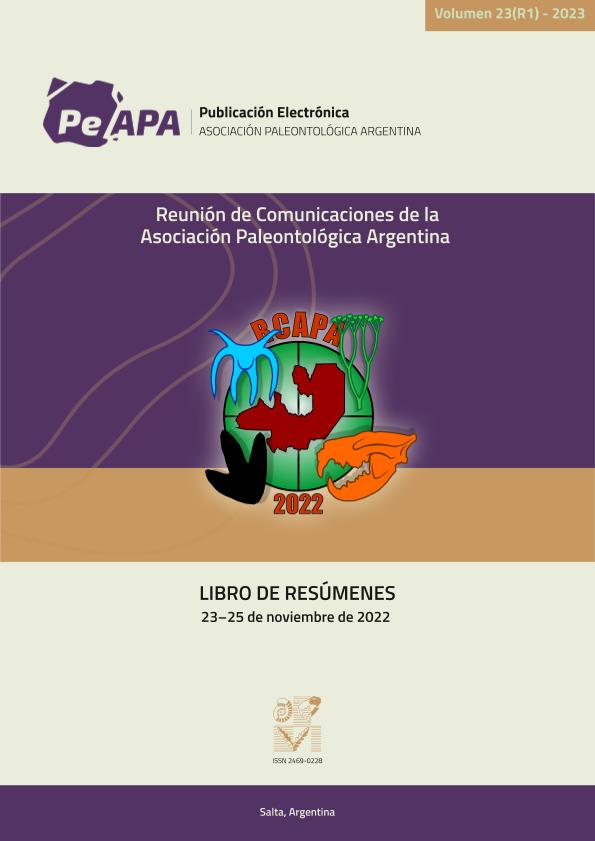Evento
The inner ear of Propalaehoplophorus Ameghino (Xenarthra, Cingulata, Glyptodontidae)
Tipo del evento:
Reunión
Nombre del evento:
Reunión de Comunicaciones de la Asociación Paleontológica Argentina
Fecha del evento:
23/11/2022
Institución Organizadora:
Asociación Paleontológica Argentina;
Consejo Nacional de Investigaciones Científicas y Técnicas. Instituto de Bio y Geociencias del Noroeste Argentino;
Universidad Nacional de Salta. Facultad de Ciencias Naturales. Instituto para el Estudio de la Biodiversidad de Invertebrados;
Título de la revista:
Publicación Electrónica de la Asociación Paleontológica Argentina
Editorial:
Asociación Paleontológica Argentina
ISSN:
2469-0228
Idioma:
Inglés
Clasificación temática:
Resumen
The anatomy of the extant xenarthran inner ear has shown a correlation between the semicircular canals with functional aspects related to locomotion, as well as their phylogenetic history. Since so far, studies of the inner ear of extinct xenarthrans are known for folivorans, pampathers and some glyptodonts. Yet, the inner ear of "Propalaehoplophorinae" glyptodonts (the oldest glyptodonts which cranium is known) remains unknown. The aim of this study is to describe the bony labyrinth of the inner ear of the glyptodont Propalaehoplophorus Ameghino (YPM-VPPU, Yale Peabody Museum, 15007), from the Santa Cruz Formation (early Miocene) of Patagonia (Argentina), which was observed using micro-computed tomography, and subsequently reconstructed in 3D. The bony labyrinth (i.e., cochlea and semicircular canals) presents a general gracile appearance with small and relatively thin semicircular canals, including a proportionally long and slim common crus, between the anterior and posterior semicircular canals. As in other glyptodonts (e.g., Glyptodon, Doedicurus, Panochthus, and Pseudoplohophorus) and the armadillo Chlamyphorus, a reduced secondary common crus, between the posterior portion of the lateral semicircular canal and the ventral one of the posterior semicircular canal, is present. Ampullae are robust. As in other glyptodonts, the cochlea has less than two coils, with an appreciable and large space between the poorly coiled proximal section from the more tightly coiled distal one. The secondary bony (basilar) lamina sulcus of the cochlea is indistinct or not observable in other glyptodonts (previously mentioned), but it is present in Propalaehoplophorus with a reduced extent. This preliminary description, shows that the inner ear of Propalaehoplophorus is similar to the inner ear of aforementioned glyptodonts and most extant armadillos (e.g., Dasypus, Chaetophractus and Zaedyus, among others) (particularly with Chlamyphorus). Even though some variability is observed among glyptodonts, which indicate that the Miocene glyptodont Propalaehoplophorus would be within the range of slow to medium-slow agility levels, along with large Pleistocene glyptodonts (e.g., Glyptodon, Doedicurus, Panochthus, and Pseudoplohophorus) and most extant armadillos (previously mentioned). Moreover, the results provided here would serve as a basis for future anatomical and functional studies based on auditory and equilibrium abilities in these Miocene glyptodonts, as to unravel phylogenetic implications, hearing patterns and locomotion evolution across Cingulata.
Palabras clave:
INNER EAR
,
GLYPTODONTS
,
ANATOMY
,
FORMACION SANTA CRUZ
Archivos asociados
Licencia
Identificadores
Colecciones
Eventos(CICTERRA)
Eventos de CENTRO DE INVEST.EN CS.DE LA TIERRA
Eventos de CENTRO DE INVEST.EN CS.DE LA TIERRA
Eventos(CIEMEP)
Eventos de CENTRO DE INVESTIGACION ESQUEL DE MONTAÑA Y ESTEPA PATAGONICA
Eventos de CENTRO DE INVESTIGACION ESQUEL DE MONTAÑA Y ESTEPA PATAGONICA
Citación
The inner ear of Propalaehoplophorus Ameghino (Xenarthra, Cingulata, Glyptodontidae); Reunión de Comunicaciones de la Asociación Paleontológica Argentina; Salta; Argentina; 2022; 99-99
Compartir
Altmétricas




